![The 1-2-3 Guide to Content Marketing for Startups [KPIs Included]](https://marketinginsidergroup.com/wp-content/uploads/2023/03/MIG-Feature-Image-Template-2024-03-21T155131.823.png)
The 1-2-3 Guide to Content Marketing for Startups [KPIs Included]
Building a successful startup is more than just creating a viable business plan. It’s also essential that your startup marketing strategy is crafted to drive awareness and exposure of your brand to the right audience. Content marketing for startups could mean the difference between failure and success.
The major aim of content marketing for businesses in the startup phase is to get the word out. When your business is new, nobody knows you exist. A lot of content marketing advice is aimed at more established businesses, but it won’t do you much good if you haven’t even built an audience yet.
With a fledgling startup to manage, you likely don’t have a huge pool of resources to tap into for your marketing. This includes budget, manpower and the most valuable and limited resource of all: time. But you can start your journey towards content marketing brilliance and the business growth it can bring with a deep understanding of your objectives, a solid content marketing strategy, and a strong focus on your customers.
You don’t need a full-staffed marketing team or million dollar marketing budget. You just need to take the first steps. And, when you get it right, you are that much more likely to see your startup transform into an established small to mid-sized business (or international brand) that your customers count on. Not just for great products or services, but also for industry information, relevant tips and insights, and a sense of belonging as you use your content strategy to build a three-dimensional brand community.
We’ve put together this guide as an easy step-by-step process that any startup can follow if they want to make the most out of their content marketing.
Quick Takeaways:
- When your business is just starting out, content marketing is one of the most affordable and effective marketing methods. It can help new brands build awareness, establish an identity and niche, attract ideal customers, and generate leads and sales.
- A content marketing program is a carefully developed plan that encompasses strategy and gives you a roadmap for executing key objectives. Building one for your startup involves careful thought, planning, creativity, effort, and resources.
- Keep the focus on your customers and their needs, not your company.
- Review your content strategy regularly to make sure you’re reaching the right audience with the right message.
Why Do Startups Need Content Marketing?
Content marketing can be an essential growth strategy for new businesses. As Seth Godin famously said, “Content marketing is all the marketing that’s left.” It can help startups build brand awareness and trust, drive organic traffic, generate new leads, build customer loyalty, drive direct sales, and much more.
Quality content – written by experienced writers in your niche and optimized for SEO – can form a foundation for other business growth strategies, like advertising, influencer marketing, customer service, and sales. Give potential customers precisely what they’re seeking at the right place and time, and you’ll start building trust. You’ll also create memorable experiences that keep people coming back for more.
Without a clear, documented plan, you could end up wasting precious resources, fail to prove the value of your efforts, target the wrong audiences, and struggle to engage users successfully. Conversely, with a solid content marketing program, you can build a loyal customer base through consistent, strategic efforts. Using the right tactics, you can turn visitors into customers and brand evangelists who can’t wait to spread the word about your products and services.
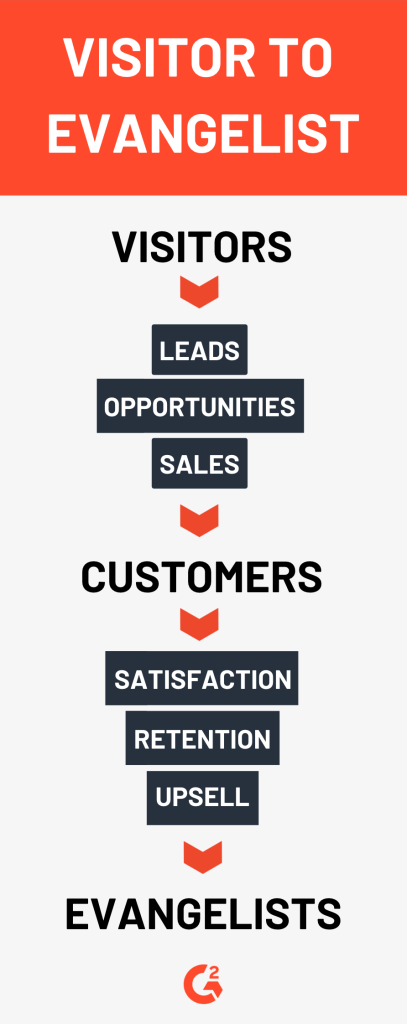
While 84% of businesses (per a Semrush survey) claim to have a content marketing strategy in place, only 11% believe they have an excellent one. To optimize your content planning, creation, and distribution efforts for maximum results, you need to set realistic goals for your business and develop a plan of attack to achieve them.
What is a Content Marketing Program?
A content marketing program is a carefully developed plan for executing key business objectives. Before designing your program, it’s essential to establish a solid content strategy. A content marketing strategy outlines how a business will produce, manage, distribute, and repurpose content over time. Your program should incorporate your content strategy.
Clarify Your Vision
First, you need to have an idea of your end result. It may take some learning and trial and error to get there, but as a startup, you already know how powerful this fluid, ever-evolving approach is for getting results. Here’s a glimpse of the ideal you’ll have with your content:
- If you’re a startup, start blogging immediately. Include in-depth blog posts, podcasts, and vlogs.
- Email newsletters offering varied customer delights – promotions, eBooks, news, links to video content, registration to events
- Brand social media pages that act as a platform for customer service, customer relationship building and for thoughtful posts that generate demand
- Regular events such as webinars, in-person seminars, conferences and more – marketing events are particularly valuable for B2B startups
- An elegantly designed website with well-structured landing pages and clear navigation to seamlessly entice and convert the site visitors you worked so hard to attract into leads, and leads into customers
And, here’s the inspiration to show you what happens when you work towards making your vision a reality.
Blue Apron grew 500 percent with content marketing. This forward-thinking sustainable food box delivery company attributes a chunk of their mega success to their content marketing.
Blue Apron serves up tasty customer delights with regular recipes and healthy menu ideas, tons of educational content in enjoyable formats, fantastic food photography, and enticing lead capture forms on their website. They also don’t follow a content playbook but rather use creativity, delivering fresh, out-of-the-box content that perfectly tailors to their market.
Mint is another startup superstar. Today everyone is familiar with this personal finance brand. The company officially launched in 2007. Two years and 1.5 million customers later, it sold for $170 million to Intuit. When founder Aaron Patzer came up with the idea for Mint, he took the marketing aspect very seriously right from the start. Patzer would walk up to random people at a train station and ask which of his tagline ideas resonated the most with them. Talk about affordable market research.
Today, Mint is not only established as the top personal finance app, it’s also endlessly helpful to consumers with the Mint Life blog and masterful social media posts that appeal to a large audience. A decade after launch, this once startup, now turned juggernaut, boasts over 20 million users.
Set Goals for Your Content Marketing
It’s critical for startups more than any other kind of business to make sure they’re being efficient with their time and resources.
When you’re trying to get a new business off the ground, you’re often working with a small budget, a small team, and there are hundreds of business tasks that need your attention.
This is why startup founders have such long working hours – 80-hour weeks are common. When you’re starting a new business, you’re probably bootstrapping or working with other people’s money, and the pressure is on. You’re trying to do everything yourself and juggling many different things, all of which are critical to your business.
The last thing you want to do in this situation is waste time on marketing activities that end up not bringing you any benefit.
This is part of the reason why content marketing should be a major part of marketing strategy for most startups, as it offers a higher ROI than other types of marketing.
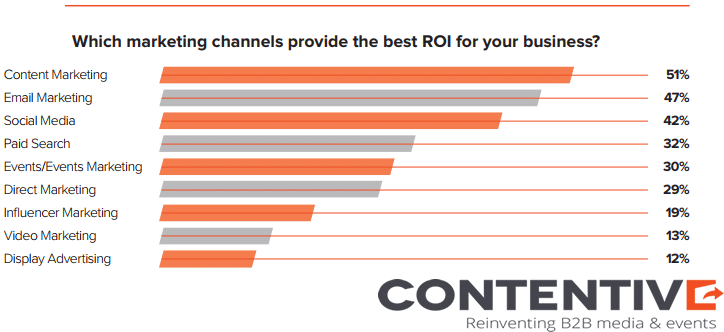
But you can’t just assume a scattershot approach to content marketing and expect to achieve an impressive ROI without a strategic approach. It’s essential to set goals and review regularly to ensure you’re staying on track and being efficient with your time.
Determine Your KPIs
When you’re setting goals, it’s best to focus on a few main key performance indicators or KPIs. But before you can choose these KPIs, you need to have a clear idea of what exactly you want to achieve from content marketing. This might include:
- Building brand awareness and trust
- Driving traffic to your website
- Increasing followers and engagement on social media
- Generating leads and sales
Of course, most businesses will have all those goals and more. But it’s best to concentrate on a few main goals when you’re just getting started. Once you’ve nailed down your primary goals, you can define KPIs to measure and track.
Start by identifying your top business objectives. What do you want to accomplish through content marketing? What are your top priorities for year one? Do you want to focus on building brand awareness, generating revenue, or creating a seamless customer experience?
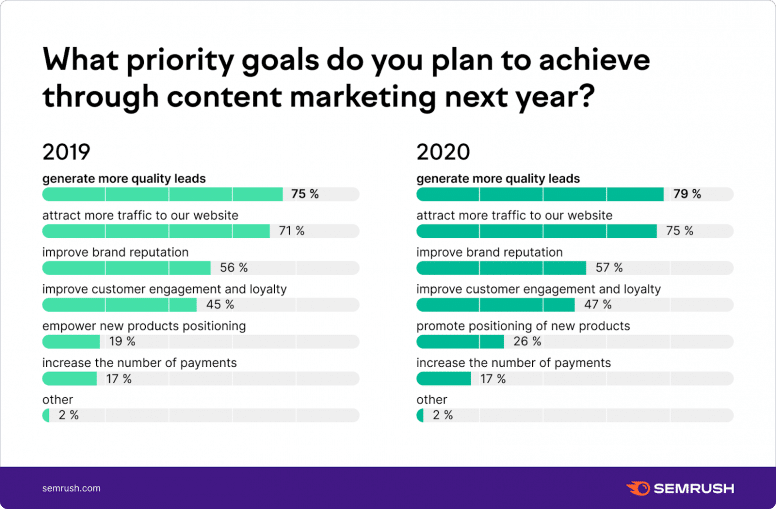
Source: Semrush
Your KPIs will be related to your website, email, and social media metrics and should normally define specific numbers such as:
- A specific number of people on your email list
- Increasing your website traffic by a certain percentage
- Achieving a specific number of social media shares
- Improving your search engine rankings by aiming for a specific SERP position or increase for your main keywords
- Increasing your brand mentions online by a specific percentage
- Reducing your website bounce rate to a set percentage
- Achieving a specific number of whitepaper or e-book downloads each month
- Increasing your conversion rate by a specific amount
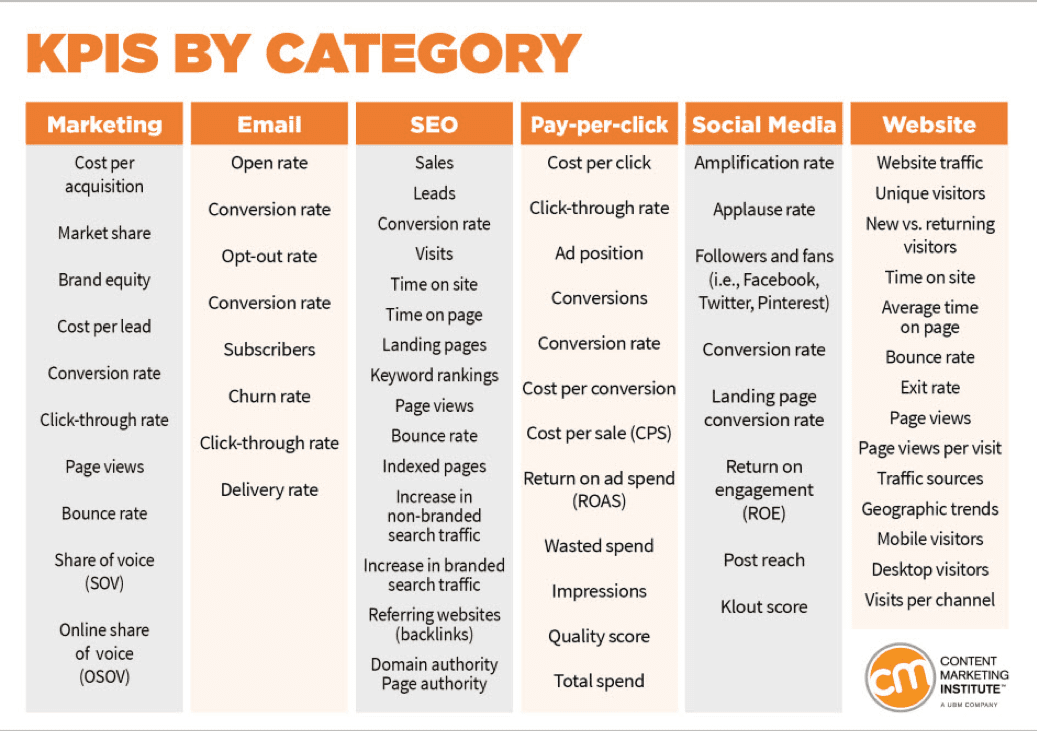
Define, Identify and Understand Your Audience
The next step is to develop a really clear understanding of exactly who you’re speaking to when you create your content. This is an important process to go through as if you miss the target here, you’ll be limiting the effectiveness of your content, no matter how high-quality it is.
If you target the wrong people, you could spend a lot of time and money attracting leads and traffic to your website that, ultimately, won’t be profitable for your business. Pinpointing the right types of leads to target is key to identifying relevant keywords, topics, and messaging for your marketing.
Your primary audience is the group most likely to buy from you. Your content should target them first. Your secondary audience may require more convincing before making a purchase, but they’re still within reach.
A good tool for understanding your audience is by developing buyer or audience personas that represent key segments of your audience.
An audience persona is a fictional character that represents this particular audience segment. When you’re creating content for an audience, it can be difficult to picture who you’re writing for. A persona provides this mental picture and description for you, and it can help you to create better content as you’re always writing with this person in mind.
The idea is not to create these personas out of thin air, but to research your current audience and target market so you can understand them better. Make sure this research includes:
- Demographics such as age, gender, location, and income
- Psychographics
- Their likes and preferences
- Their needs, challenges and pain points (and which problems YOU want to help them solve)
- How they spend their time online (including which social networks) and their most-used digital channels
- What type of content they prefer to consume (short social media posts, long-form blog posts, infographics, or videos?)
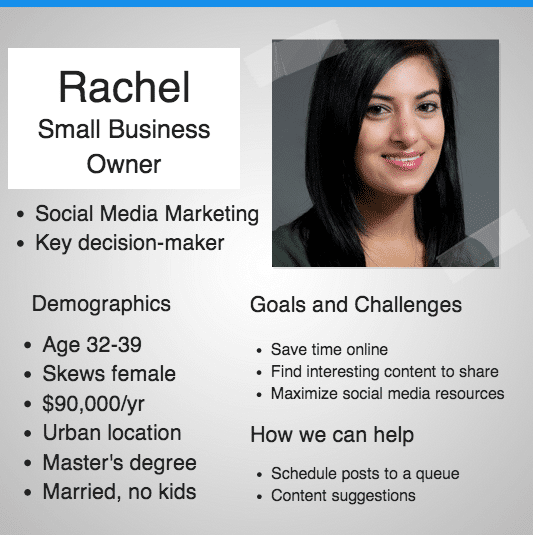
Your research should also include the questions your audience is asking, and how you can help them by providing the information they’re looking for. The basis for this is keyword research, which will also give you insight into what sort of content you should create.
Remember, the secret sauce of success in content marketing is: customer-centricity — solving the problems your target customers face. The whole point of content marketing is to position yourself as a trusted authority in your field by helping people conquer their challenges, whether in business or life.
Research Competitors’ Content
As well as researching your audience, it’s well worth investing some time in researching your competitors and other established businesses in your industry or niche.
What sort of content are they producing? Which content is seeing the most engagement? How is their audience communicating with them online?
Researching and answering these questions based on the most successful businesses in your space will give you a blueprint to follow to see success yourself. AI and automation software can help a lot here. Try out the plethora of competitive intelligence tools available in the market and use a couple that work well for you.
Of course, this doesn’t mean copying all the content on another blog. But if you can see what type of content is performing best, you can save time and maximize your ROI by creating a similar kind of content yourself.
Establish Your Content Marketing Budget
How much of your marketing budget will you allocate to content marketing? On average, B2B businesses spend around 25% of their total budget on content marketing. However, the most successful companies allocate closer to 40%.
As a startup, expect your budget to evolve – based on how well your content performs. Consider starting on the lower end of the spending spectrum. Once you have proven strategies in place, you can consider boosting your budget to make a more significant impact.
To establish your budget, consider:
- Your content marketing team
- The tools, platforms, technology, and software you need
- What types of content you’ll create and publish on which channels
- Any outsourcing costs
- Advertising and promotion costs
Map Out the Buyer’s Journey
What journey do you want a prospect to take from the moment they interact with your brand or visit your website to the moment they make their first purchase? You should address challenges and pain points prospects may face throughout their entire experience. This involves producing content for every stage of the buyer’s journey: awareness, consideration, and decision.
Mapping out the buyer’s journey for your business can help you identify specific consumer pain points, motivations, and triggers. Your content should encourage users to move from one stage to the next until they make it through the entire sales funnel. Remember that the journey doesn’t end after you convert leads into customers. How will you continue engaging your customers to build long-term loyalty?
The bottom line for any piece of content you produce is the value it provides to the consumer. This means shifting the focus away from self-promotion or sales – customers will see through this and you can end up coming off as insincere.
Consistently provide takeaway knowledge for your audience that answers common questions and sheds light with useful tips.
A great place to start is with a blog on your website that talks about all the ins-and-outs of your industry. Your content strategy needs to make sure that each of your posts is geared towards a customer segment at a particular stage of your sales cycle. For example, property search and records platform Arivify regularly creates blog postings relevant to their industry while touching on the specific intent of their followers or subscribers.
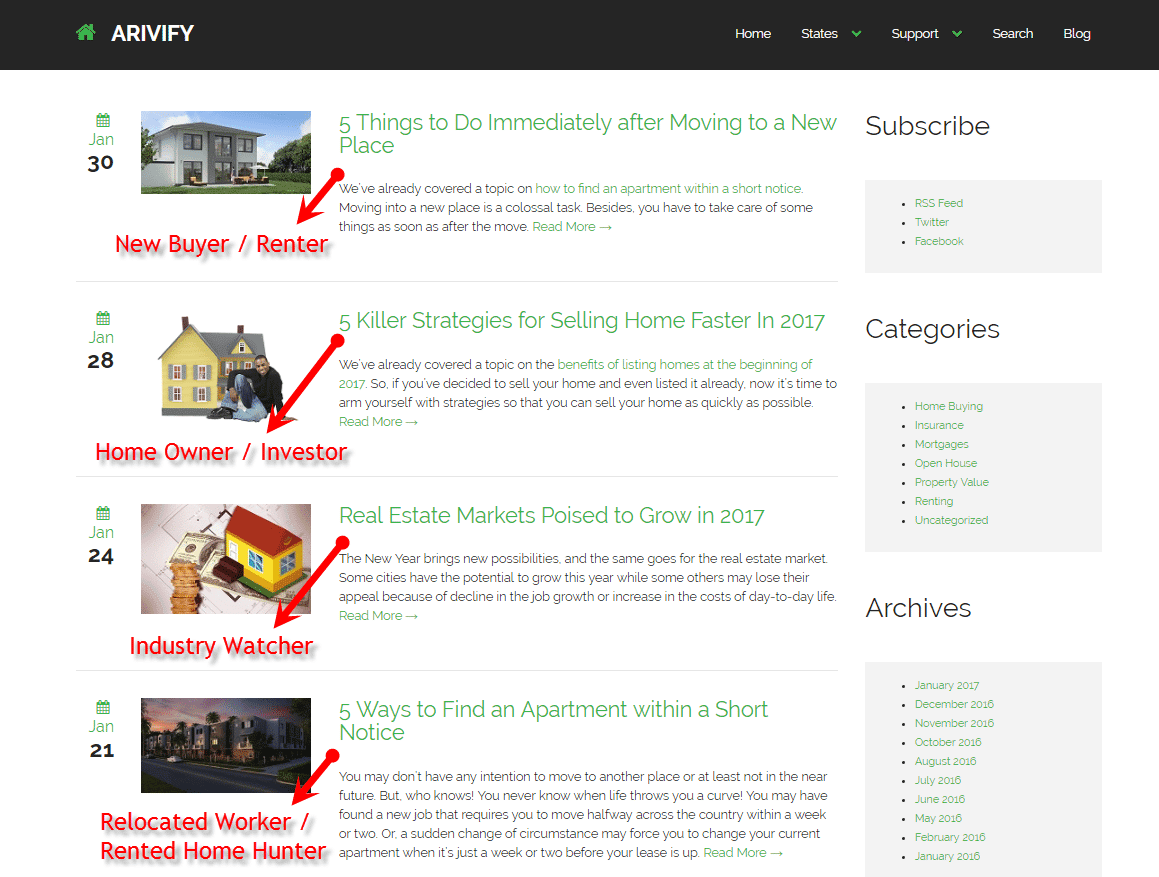
Every small business or organization can start with this fundamental approach to content marketing.
Keep in mind, every piece of relevant content you create should work to guide viewers to a reaction and eventual conversion. Even the most basic cycle consisting of just awareness, evaluation, and purchase can pose as extremely difficult when crafting content.
In the awareness stage, your content should address specific issues that the audience is likely dealing with. In the evaluation stage, the content should provide as much information as possible to help reduce the risk factor the user is about to take when buying. Post purchase, you should reassure them why they made the right decision and where they go from there.

There should always be a clear answer for how your content addresses every interaction along the consumer’s path to purchase. SiriusDecisions found that 65% of B2B content goes unused because content isn’t strategically mapped to buyer interests and topics they care about. Which is why it’s essential that you define the buyer’s journey, sales stages, and map the content associated with each of these stages so that it matches the customer’s intent at all touchpoints:

Creation and promotion of such in-depth, targeted content involves concerted efforts across your marketing, sales and customer service people, who need to have complete understanding of your content goals and KPIs. Only then can you hope for the buyer’s journey to be perfectly aligned with a closed-loop marketing-sales-support funnel:

Feel free to customize this template according to your content strategy and incorporate your own sales stages and goals.
The important thing to remember here is, every strategic decision you make should be backed up with data. This means using the proper tools to track each piece of content thoroughly to determine what components your audience is most receptive to. Content marketing is a process that should constantly be improving. Without data-driven results, you will not have insights to build on.
Choose the Best Content Types
The types of content you choose to create will depend on your audience and industry. What content formats are the leaders in your industry producing? What does your target audience love to consume? How do they most commonly look for answers online?
A blog is an excellent way to build a strong foundation of content and domain authority by publishing valuable content consistently for your audience. Blog posts are also easy to share, promote, and distribute. Standard blog formats include:
- Listicles
- How-to articles
- Interviews
- Pillar pages
- Guides
- Checklists and cheat sheets
- Guest blog posts
Regularly publishing on social media is another beneficial strategy for many businesses. Social media is one of the best ways to engage with consumers on a personal level. It humanizes your brand. Often, you can repurpose content you already have and share it on social. Social media posts can empower your business to reach more prospects and build authentic relationships with consumers through organic and paid marketing campaigns.
Here are several other popular content formats for modern businesses:
- Ebooks and guides
- Podcasts
- Videos
- Infographics
- Case studies
- Paid ads

Identify Relevant Content Channels
Once you know which types of content you’re going to focus on, you can identify the most relevant channels for distribution and promotion. Email marketing, social media, and SEO are three of the most effective ways to get your content in front of the right people as a startup. You can find additional channel opportunities by studying your competitors and prospects using tools like BuzzSumo and Alexa.
Have a Documented Content Plan
If you don’t already have a well-documented plan, you’re not alone. Only 37 percent of B2B marketers and 40 percent of B2C marketers have one that is written out. However, just because other companies fall short when it comes to creating a plan, that doesn’t mean you should leave your content marketing strategy to the wind. Which isn’t actually a strategy at all.
The trick to creating an effective strategy is to stop doing and start strategizing. Drop the pen, stop typing. Put down the camera and save your graphic design file. It’s time to map out your content marketing strategy.
Under the assumption you have a modest startup budget, here are the guidelines that will help you get your content marketing gears spinning.
Plan everything way in advance. Smart content creators have their blog posts and keywords mapped out weeks ahead of time. This will help ensure you have consistent content, even on days when you have zero time to work on your startup’s marketing (let alone to think!). It will also give you peace of mind.
Make your content topics cohesive. From written blogs to webinars and video posts, each piece of content needs to fit into the whole. Always ask yourself, how does this post or infographic support the content that surrounds it within the jigsaw of your strategy? As an example, your social posts should promote website content. When you interview an industry expert for your podcast, ask your interviewee to write a guest blog post. Your how-to videos should answer the questions that were brought up at your last webinar or from your last customer survey.
Build a Content Calendar
Your content marketing program should also cover how you’ll organize and create your content. Developing a content calendar will help keep everyone involved on the same page and on track. Create a well-thought-out, diverse, and balanced one. You can create one for the next month, quarter, half a year, or even an entire year. Content calendars allow teams to be proactive and work ahead.
Your content calendar will help you stay on track with content production and promotion, and ensure that your content marketing is aligned with your overall marketing strategy.
Also determine your publishing schedule. Consistency is key, so choose a plan your team can realistically stick to. The “sweet spot” for blogging depends on your overarching goals. For building organic traffic, shoot for publishing three to four blog posts per week. If your main goal is to build brand awareness, post one to four times a week.
No matter how limited your time and resources are, it’s important to stay consistent with your content plan. Publishing a burst of new content for a few weeks and then going silent for months will do you no good at all. It’s critical to stick to a regular publication schedule, and a content calendar is the main tool for helping you do this.

Start Blogging Already
Here comes the fun part – creating new, customer-centric content to fill your website and other chosen distribution channels. While you may be intimidated at first, you don’t have to go into content marketing blind. There are some tried and true methods to getting off the ground with content marketing. Blog writing is the easiest way to get organic hits on your website by creating quality pieces that those who fall into your customer profile are already searching for.
This process is especially beneficial for top of the funnel prospects seeking information before they purchase. Creating context about why they need your item and leading them to the conclusion is key.
For example, let’s say your startup sells grilling aprons. Creating content focused around keywords like recipes or grills will bring your target prospects (grillers) to your site. As they read your blog, they’ll realize “Wow, I DO need a grilling apron for all this brisket I’m cooking!”
Some articles you’d write using this example would be:
The 15 Best Tools for Your Grill
Top BBQ Recipes for the Summer
What Sauces are Best for Grilling?
This isn’t just for selling products; the same idea applies to selling services too! If you’re trying to gain clients for say, your real estate business, some article ideas include:
What to Look for When Buying a House
10 Things First-Time Homeowners Get Wrong
Best Places to Live in <Neighborhoods in Target Region>
By producing the answers to questions your prospective clients already have, you are creating a direct connection to your site and services though your blog writing.
The more you get into a rhythm with content creation the quicker you’ll get a read on how often to post. Ideally, you want to be pumping out this new content daily. The effectiveness of your blogging increases exponentially when you go from publishing 1x per week to 4x.
If you’re struggling to find inspiration or just don’t have the time, consider hiring a guest writer! Guest writers can provide legitimacy to your brain with their expertise and even bring over their audiences to your site. Not to mention, they probably already know how to write the perfect blog post.
Along with regular blog posts, you can also use gated content on your website. Gated content is the premium stuff (content that can earn you money directly) that is only accessible by completing a form that gives you either data or revenue.
Think about the buyer’s journey when developing every piece of content. Your blog posts, for example, should encourage users to take the next step on their path toward purchase. You might include a call to action that encourages readers to sign up for a free consultation or subscribe to a newsletter. It all depends on your goals and how you plan to move prospects organically down the sales funnel.
Graduate to In-Depth, Long Form Content
Once you get the hang of blogging, it’s time for you to put your nose to the content grindstone and create a longer piece of content like this 4500-word beast I wrote on how content marketing delivers ROI.
And do that frequently.
You could also turn that long form content into a white paper, a webinar, or a longer, more detailed video.
But don’t despair. Unlike when you were in school yourself, if you don’t have time to work on such a large undertaking, you can always outsource content creation to one of the many companies that specialize in that task.

A good way to tell whether outsourcing will give you more bang for the buck is to calculate how much your business earns you per hour. Now, estimate how many hours you would have to spend to create that content. If it would cost your business more to create that content than to outsource, choose outsourcing.
Distribute, Market, and Promote Your Content
Content marketing isn’t just about publishing content, and it’s also important to make sure you’re promoting your content in the right places. Your audience research should guide this, and most startups use a variety of content promotion tactics.
To get the most out of every piece of content you create, maximize your efforts by distributing and promoting it across various channels. Depending on your budget, channels could include:
- Paid advertising
- Social media marketing and ads
- Email marketing
- Search engine optimization
- Influencer marketing
- Search engine marketing
- Sponsored content
- Guest posting
SEO is the other side of the content marketing coin, so make sure you find some affordable SEO services and include it as a basic add-on in your content marketing budget
Let Influencers Steer Your Marketing
Another great way to broaden your scope is influencer marketing, which involves finding a public figure to mention your brand to their large following pertaining to your industry. Three of the biggest reasons why influencers are effective in driving word of mouth are:
- Bigger reach – According to Attentive.ly, the top 5% of influencers reach 85% of the extended social network. Finding the right influencers for your campaign is the key to escalating your current reach.
- Personal stake – In most cases, influencers support causes because in addition to spreading a positive message, it helps bolster their own reputation and credibility. This provides motivation for them to do a stellar job in promoting projects by getting the word out to the best of their abilities.
- Unbeatable ROI – Influencer marketing is by no means a new phenomenon. But with the rise of the internet and social media, it has become an extremely profitable strategy. In fact, a study by Ogilvy, Google and TNS found that 74% of people look to social networks for guidance on purchasing decisions.
For instance, back in 2015, the Bubble Foundation was in for a treat when they began the “Wear Yellow for Seth” campaign. Seth, a young boy with a deadly disease, happened to love the color yellow. So his parents kindly asked the world to wear yellow and post a picture with the hashtag. The campaign went crazy and attracted huge names like Ashton Kutcher.
Lets make this little dudes day! #wearyellowforseth http://t.co/WMsTsx6JHA pic.twitter.com/RslnmBlNSf
— ashton kutcher (@aplusk) March 27, 2015
This just goes to show that the size of an organization does not matter. With the right material and messaging, multiple influencers can hop onboard your “brandwagon” and skyrocket awareness. Assuming you play your cards right, your influencer marketing efforts could blossom into a full-blown campaign and a close partnership. In turn, your brand exposure and website visibility will go through the roof.
Use the Latest Tools
There are a lot of great digital marketing tools and content promotion tools out there to help gain answer these potent questions and chart your course accordingly.
Buzzsumo is a platform that lets you search for the type and formats of content performs the best within your field. It also helps you identify which influencers will fit best with your strategy for a given platform.

Brandwatch lets you to tap into what people are saying about your brand or business on social media. From here, you can gain data-driven insights about you, your competitors, or your industry as a whole.

Here are some more tools we’ve found handy, especially for startups on a budget:
- Google Docs: You don’t need to spend money on a word processor when you can get Google Docs simply by having a Gmail account. It shares many of the same features as paid word processors, and it has one advantage none of those have: you can collaborate in real time with members of your team whose input you want.
- Google Keyword Planner: This free tool allows you to find the right words to focus your content around. Simply plug in your products and services, and the tool will spit back a long list of related words, along with the number of searches for those words.
- WordPress: To start with, you can begin your blog with one of WordPress’s free website domains. As you gain traction and customers, you can migrate your content to their hosted paid version with a custom URL with your own brand stamped on it.
- Google Analytics: Learn all about your blog or website’s audiences and the actions they take while they’re on your site. The more you know about your audience, the better you can tailor content to them.
- Your smartphone and/or camera: Although it’s not exactly free, you probably already have one. Use it to create how-to videos and photos that showcase your products or services.
- MailChimp: Use this helpful tool to send targeted emails and newsletters to various customer segments, as well as serious prospects. Keep informed about new posts, as well as exclusive offers, such as e-books or white papers, that you offer only to subscribers.
- DivvyHQ: Divvy is a content planning and workflow collaboration platform we use with our clients to manage our annual content plans, collaborate across our team, and get content published and shared to the right social platforms.
- Grammarly: Never worry again about your fourth-grade English teacher reading your posts. Even the free version of this grammar and spelling checker finds most of your errors.
Analyze and Review Your Content Success
Your job isn’t over once you’ve published a piece of content and promoted it on your major marketing channels. A key step that can’t be overlooked if you want to achieve success in content marketing is continually analyzing your content campaigns so you can identify what’s working and where you can improve.
Measuring the success of your content should be a part of your strategy, not an afterthought. Especially as a startup, careful consideration of the response and effect of your content will allow you to quickly refine your strategy until it does make a serious impact. If you aren’t tracking your content, you could be wasting time and money.
For example – how much does website traffic change after you change the tone of your tweets and Facebook posts? What happens to your email click through rates when you post a link to a video, better personalize your closing or simply shorten (or lengthen) the text? Did your email contact list grow after you published an eye-catching infographic? The more questions you ask of your content, the more answers you’ll get. You may find that certain channels are more effective than others or that specific content formats resonate better with your audience.
This is the point where you refer back to your KPIs so you can measure your progress and optimize your content processes. You may not hit all your content goals as soon as you’d hope to, but this is OK.
As long as you’re tracking progress and identifying areas for improvement, you’ll be ensuring your content marketing success and efficiency are increasing over time.
Measure Audience Retention
Retention metrics shed light on how well you are able to hold onto an audience with your content. It is absolutely imperative to find out what percentages and segments of viewers return to your website and individual pieces of content, if you harbor hopes of calculating the ROI on your content marketing with any degree of certainty.
It’s also important to keep tabs on the frequency of returns – this shows how relationships are developing between you and your audience, in terms of how they see you as a trusted resource. A study reported on Chartbeat found that people who visited a site at least five times per month were more likely to develop a pattern of returning, and eventually purchasing.

There are several key metrics that can help you analyze how your audience perceives the content on your website.
- New vs. Returning Visitors – This ratio gives you an idea of how effective your content is in attracting new audiences and growing your community. Also, by drilling down into and comparing the number of sessions, pages viewed, and time spent each by both these segments, you can get a very good idea of the kind of content that either segment prefers.
- Bounce Rate – This refers to the number of people who land on your website and leave without engaging. While a bounce can have a number of causes, it generally indicates how interested people are in your content, how useful the information is, or how relevant the landing page is to them. There are a several ways to improve your bounce rate, depending on your audience and industry.
- Exit Pages – These are the last URLs visitors see before leaving your site. By analyzing reading patterns, scrolls and clicks on the elements on these pages, you can identify obstacles in your content funnel that are putting visitors off, and optimize for micro-conversions accordingly.
At the end of the day, retention metrics reveal whether how well your content is working to build a loyal following for your brand or not.
Become Part of the Big Picture
One of the biggest things startups and SMBs can learn from large companies is the power of storytelling and becoming part of something bigger than themselves. This is one of the integral parts of effective content marketing.
There are multiple ways in which businesses can create emotional connections with customers, one of the best of which is to become part of a social cause. This approach is extremely effective with younger consumers. In fact, nine in ten millennials would switch brands to one associated with a cause that appeals to them.
A brand that deeply understands and rides this phenomenon is Patagonia, who are known for being environmentally-conscious in all their operations. They also promote their users’ stories (who brag about the amazing things they do while sporting their Patagonia purchases).
Patagonia used storytelling beautifully in their “Worn Wear” campaign, which aimed to encourage people to recycle or repair their clothing, eventually lowering the need for companies to make new items or spend resources.

Interactive content is your friend here. Unsurprisingly, the top brands are already sampling different forms of content that can help them do this. For instance, Boeing launched a website an interactive library that tells the story behind everything from World War 1 to the first stewardess, Ellen Church. Renault launched an interactive movie, the first big brand story in which viewers can decide the beginning, the middle, and the end.

While you might not have that sort of budget, interactive content isn’t all that hard (or expensive) to produce on a smaller scale. It might just give your otherwise ordinary content the crucial nudge it needs to go viral.
One of the big goals in content marketing is to create a community based on mutual interests and values. To do this, you must align consumer goals and desires with your strategy. What is the most important thing to your audience? What do they stand for? What are their biggest concerns or questions?
More Power to You
Your strategy should always be evolving with creative breakthroughs that boost awareness, and ultimately conversions. The bottom line is: know what your audience wants and deliver it to them in an innovative way. Leave preset notions about your business behind and set out to create content that’s not just useful, but fascinating to users. Using influencers while supporting a cause should work to broaden your audience and appeal to consumer values in a profound, creative way. That is the beauty of content.
By following the fundamental rules outlined here, it’s hard for you to go wrong. If you turn your brand into a publishing heavyweight in the process, more power to you!
Need Help Creating an Effective Content Marketing Program for Your Startup?
We are a content marketing agency that creates quality, engaging, SEO-driven content to help businesses reach and engage consumers at every stage of the buyer’s journey. We can build a customized content marketing program to help you produce all the content needed to win new customers. We’ll also measure and calculate ROI so you know precisely how successful your efforts are over time.
Our team will research your target market to gain a deep understanding of your buyer personas and industry. Then we’ll develop keyword-rich content that meets prospects where they are and leads them seamlessly down the sales funnel.
Learn more about our Content Builder Services.


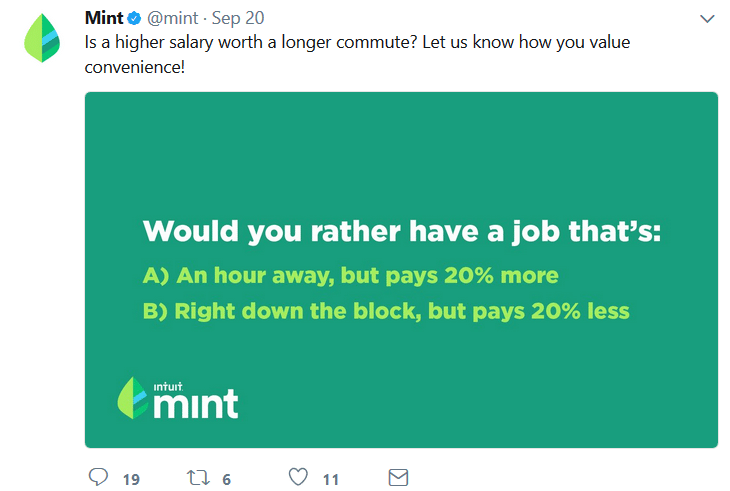
![How to Create Effective Thought Leadership Content [Examples Included]](https://marketinginsidergroup.com/wp-content/uploads/2023/09/Screenshot-2023-08-29-at-11.07.57-AM.png)
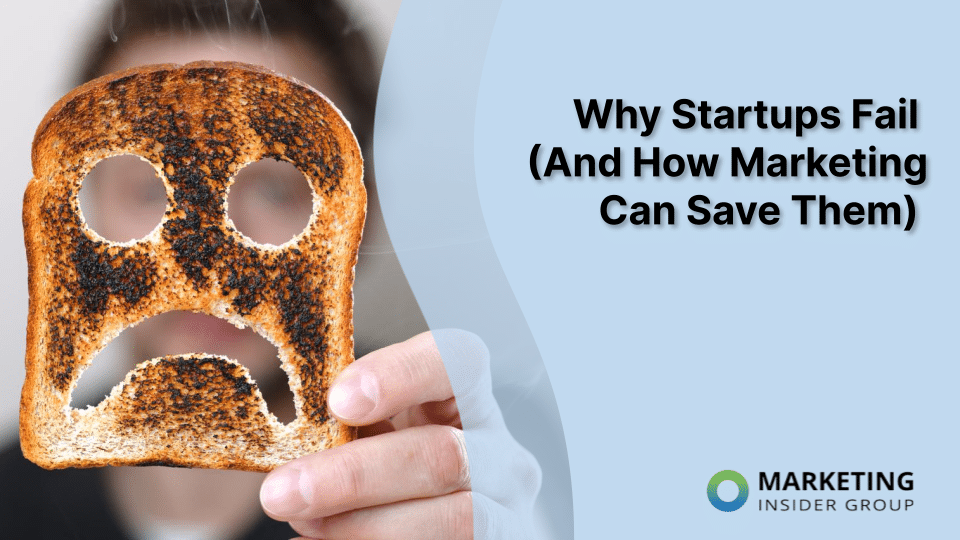




I love the article article! I hope you don’t care if share it in my business page.